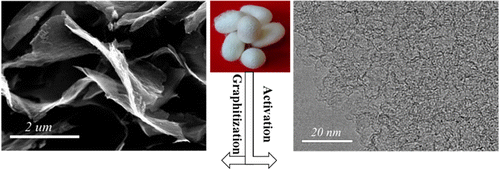Silk could be new 'green' material for next-generation batteries

Lithium-ion batteries have enabled many of today's electronics, from portable gadgets to electric cars. But much to the frustration of consumers, none of these batteries last long without a recharge. Now scientists report in the journal ACS Nano the development of a new, "green" way to boost the performance of these batteries—with a material derived from silk.
Chuanbao Cao and colleagues note that carbon is a key component in commercial Li-ion energy storage devices including batteries and supercapacitors. Most commonly, graphite fills that role, but it has a limited energy capacity. To improve the energy storage, manufacturers are looking for an alternative material to replace graphite. Cao's team wanted to see if they could develop such a material using a sustainable source.
The researchers found a way to process natural silk to create carbon-based nanosheets that could potentially be used in energy storage devices. Their material stores five times more lithium than graphite can—a capacity that is critical to improving battery performance. It also worked for over 10,000 cycles with only a 9 percent loss in stability.
The researchers successfully incorporated their material in prototype batteries and supercapacitors in a one-step method that could easily be scaled up, the researchers note.
More information: Hierarchical Porous Nitrogen-Doped Carbon Nanosheets Derived from Silk for Ultrahigh-Capacity Battery Anodes and Supercapacitors ACS Nano, Article ASAP. DOI: 10.1021/nn506394r
Abstract
Hierarchical porous nitrogen-doped carbon (HPNC) nanosheets (NS) have been prepared via simultaneous activation and graphitization of biomass-derived natural silk. The as-obtained HPNC-NS show favorable features for electrochemical energy storage such as high specific surface area (SBET: 2494 m2/g), high volume of hierarchical pores (2.28 cm3/g), nanosheet structures, rich N-doping (4.7%), and defects. With respect to the multiple synergistic effects of these features, a lithium-ion battery anode and a two-electrode-based supercapacitor have been prepared. A reversible lithium storage capacity of 1865 mA h/g has been reported, which is the highest for N-doped carbon anode materials to the best of our knowledge. The HPNC-NS supercapacitor's electrode in ionic liquid electrolytes exhibit a capacitance of 242 F/g and energy density of 102 W h/kg (48 W h/L), with high cycling life stability (9% loss after 10 000 cycles). Thus, a high-performance Li-ion battery and supercapacitors were successfully assembled for the same electrode material, which was obtained through a one-step and facile large-scale synthesis route. It is promising for next-generation hybrid energy storage and renewable delivery devices.
Journal information: ACS Nano
Provided by American Chemical Society


















